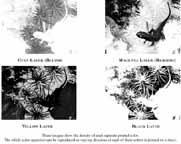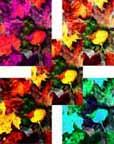|
Cool Colors
 Each pixel on the monitor is composed of varying amounts of the 3 primary colors - Red, Green, and Blue. These additive colors are based on the light intensity of each color to produce the full spectrum. The three colors added together at their brightest produce white, while the absence of all three yields black. Each pixel on the monitor is composed of varying amounts of the 3 primary colors - Red, Green, and Blue. These additive colors are based on the light intensity of each color to produce the full spectrum. The three colors added together at their brightest produce white, while the absence of all three yields black.
On a printer, however, the subtractive colors, cyan, magenta, yellow are used. The absence of
ink on a white sheet produces white, and adding equal parts of each will theoretically produce
black. Because of impurities in the ink, the combination actually produces a muddy brown, so
black (K) is added as a fourth color to add depth to shadow areas and neutral colors. These are
the CMYK colors used in 4 color printing.
The Epson printer I'm using is a 7 color printer. It adds a second tonal variation of
cyan, magenta, and black to help reproduce the subtle tone variations found in nature photography.
Was It Really Like That?

Any picture must be touched up for dust, spots, and scratches, and then is corrected for color and contrast. Corrections can be made on the whole image, or just selected parts of an image. This can be done by adjusting the hue and saturation of the color, or individually adjusting the balance and depth of each color. Once all the color corrections and tonal adjustments are made, the layered master file is saved for future reference.
page 1 2
3 4
|





